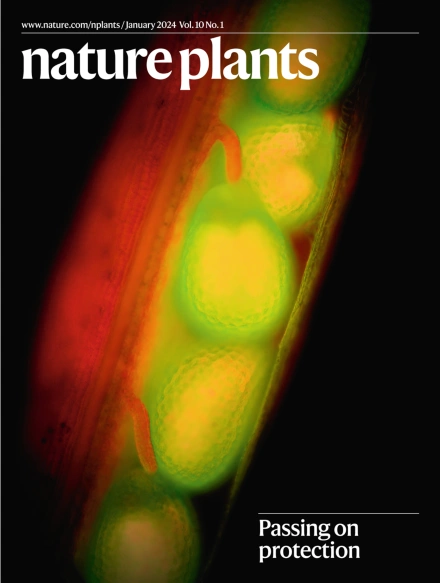细胞壁相关激酶磷酸化NLR免疫受体,负向调节抵抗体的形成
IF 15.8
1区 生物学
Q1 PLANT SCIENCES
引用次数: 0
摘要
植物利用细胞内核苷酸结合的富亮氨酸重复序列(NLRs)来检测病原体效应物并启动免疫反应。虽然一些植物NLR形成抗性小体的激活机制已经被阐明,但NLR抗性小体的组装是否被调节以微调免疫仍然是一个谜。在这里,我们使用抗病毒的卷曲线圈-核苷酸结合位点-富含亮氨酸的重复序列,大麦条纹抗性1 (BSR1)作为模型,并证明BSR1是磷酸化的。使用接近标记方法,我们发现了一种壁相关激酶样蛋白20 (WAKL20),它通过直接磷酸化BSR1 NB-ARC结构域的Ser470残基来负性调节BSR1介导的免疫反应。从机制上讲,Ser470磷酸化导致BSR1分子内结构域的空间冲突,从而影响BSR1的寡聚化。该磷酸化位点在多种植物nlr中是保守的,我们的研究结果表明,WAKL20参与了除BSR1外的其他nlr介导的免疫应答。总之,我们的数据揭示了磷酸化是调节植物抗性体组装的机制,并为nlr介导的植物免疫提供了新的见解。本文章由计算机程序翻译,如有差异,请以英文原文为准。


A cell wall-associated kinase phosphorylates NLR immune receptor to negatively regulate resistosome formation
Plants deploy intracellular nucleotide-binding leucine-rich repeats (NLRs) to detect pathogen effectors and initiate immune responses. Although the activation mechanism of some plant NLRs forming resistosomes has been elucidated, whether NLR resistosome assembly is regulated to fine-tune immunity remains enigmatic. Here we used an antiviral coiled coil-nucleotide-binding site–leucine rich repeat, Barley Stripe Resistance 1 (BSR1), as a model and demonstrate that BSR1 is phosphorylated. Using a proximity labelling approach, we identified a wall-associated kinase-like protein 20 (WAKL20) which negatively regulates BSR1-mediated immune responses by directly phosphorylating the Ser470 residue in the NB-ARC domain of BSR1. Mechanistically, Ser470 phosphorylation results in a steric clash of intramolecular domains of BSR1, thereby compromising BSR1 oligomerization. The phosphorylation site is conserved among multiple plant NLRs and our results show that WAKL20 participates in other NLR-mediated immune responses besides BSR1. Together, our data reveal phosphorylation as a mechanism for modulating plant resistosome assembly, and provide new insight into NLR-mediated plant immunity. The discovery of the resistosome was a milestone in plant immunity. Here, Zhong et al. identify a kinase that phosphorylates the NLR, and reveal how this kinase regulates resistosome assembly to fine-tune immune responses.
求助全文
通过发布文献求助,成功后即可免费获取论文全文。
去求助
来源期刊

Nature Plants
PLANT SCIENCES-
CiteScore
25.30
自引率
2.20%
发文量
196
期刊介绍:
Nature Plants is an online-only, monthly journal publishing the best research on plants — from their evolution, development, metabolism and environmental interactions to their societal significance.
 求助内容:
求助内容: 应助结果提醒方式:
应助结果提醒方式:


